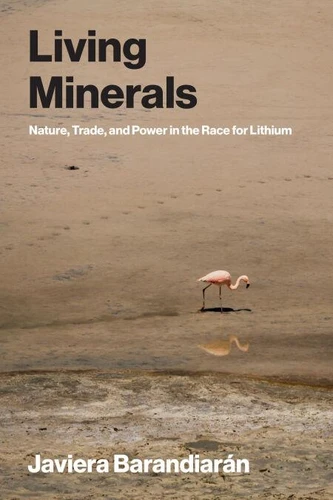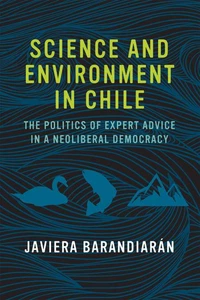Living Minerals. Nature, Trade, and Power in the Race for Lithium
Par :Formats :
Actuellement indisponible
Cet article est actuellement indisponible, il ne peut pas être commandé sur notre site pour le moment. Nous vous invitons à vous inscrire à l'alerte disponibilité, vous recevrez un e-mail dès que cet ouvrage sera à nouveau disponible.
Disponible dans votre compte client Decitre ou Furet du Nord dès validation de votre commande. Le format ePub protégé est :
- Compatible avec une lecture sur My Vivlio (smartphone, tablette, ordinateur)
- Compatible avec une lecture sur liseuses Vivlio
- Pour les liseuses autres que Vivlio, vous devez utiliser le logiciel Adobe Digital Edition. Non compatible avec la lecture sur les liseuses Kindle, Remarkable et Sony
- Non compatible avec un achat hors France métropolitaine
 , qui est-ce ?
, qui est-ce ?Notre partenaire de plateforme de lecture numérique où vous retrouverez l'ensemble de vos ebooks gratuitement
Pour en savoir plus sur nos ebooks, consultez notre aide en ligne ici
- Nombre de pages280
- FormatePub
- ISBN978-0-262-38536-7
- EAN9780262385367
- Date de parution13/01/2026
- Protection num.Adobe DRM
- Infos supplémentairesepub
- ÉditeurThe MIT Press
Résumé
A sobering investigation of the rush for lithium for electric vehicles, the problematic history of lithium mining, and the consequences for sustainability. Consumers today are buying electric vehicles with lithium-ion batteries motivated by the belief that they are doing good and decarbonizing society. But is sustainable lithium extraction possible? In Living Minerals, Javiera Barandiarán examines the history of lithium mining and uses during the twentieth century, with a specific focus on the two oldest brine-lithium mines: Silver Peak, Nevada, and Salar de Atacama, Chile, where lithium is found as one more element in a liquid mix of salts, minerals, and organisms.
For six decades, mining experts have failed to ask about water usage, about waste or brine leakage, and about the ecosystem impacts in delicate deserts. Instead, they have relied on various fictions about the size of reserves, the fate of leaked brine, or the value of waste in facilitating mine development. These fictions, rooted in brine-lithium's material qualities, could be sustained thanks to powerful mining memories that celebrated resource nationalism.
Unique in its historical and multidimensional approach to minerals and mining, based on the novel Rights of Nature paradigm, and using new archival materials from both Chile and the US, the book argues that decarbonizing society requires that we reckon with these realities-or risk deepening our dependency on an unsustainable mining industry.
For six decades, mining experts have failed to ask about water usage, about waste or brine leakage, and about the ecosystem impacts in delicate deserts. Instead, they have relied on various fictions about the size of reserves, the fate of leaked brine, or the value of waste in facilitating mine development. These fictions, rooted in brine-lithium's material qualities, could be sustained thanks to powerful mining memories that celebrated resource nationalism.
Unique in its historical and multidimensional approach to minerals and mining, based on the novel Rights of Nature paradigm, and using new archival materials from both Chile and the US, the book argues that decarbonizing society requires that we reckon with these realities-or risk deepening our dependency on an unsustainable mining industry.
A sobering investigation of the rush for lithium for electric vehicles, the problematic history of lithium mining, and the consequences for sustainability. Consumers today are buying electric vehicles with lithium-ion batteries motivated by the belief that they are doing good and decarbonizing society. But is sustainable lithium extraction possible? In Living Minerals, Javiera Barandiarán examines the history of lithium mining and uses during the twentieth century, with a specific focus on the two oldest brine-lithium mines: Silver Peak, Nevada, and Salar de Atacama, Chile, where lithium is found as one more element in a liquid mix of salts, minerals, and organisms.
For six decades, mining experts have failed to ask about water usage, about waste or brine leakage, and about the ecosystem impacts in delicate deserts. Instead, they have relied on various fictions about the size of reserves, the fate of leaked brine, or the value of waste in facilitating mine development. These fictions, rooted in brine-lithium's material qualities, could be sustained thanks to powerful mining memories that celebrated resource nationalism.
Unique in its historical and multidimensional approach to minerals and mining, based on the novel Rights of Nature paradigm, and using new archival materials from both Chile and the US, the book argues that decarbonizing society requires that we reckon with these realities-or risk deepening our dependency on an unsustainable mining industry.
For six decades, mining experts have failed to ask about water usage, about waste or brine leakage, and about the ecosystem impacts in delicate deserts. Instead, they have relied on various fictions about the size of reserves, the fate of leaked brine, or the value of waste in facilitating mine development. These fictions, rooted in brine-lithium's material qualities, could be sustained thanks to powerful mining memories that celebrated resource nationalism.
Unique in its historical and multidimensional approach to minerals and mining, based on the novel Rights of Nature paradigm, and using new archival materials from both Chile and the US, the book argues that decarbonizing society requires that we reckon with these realities-or risk deepening our dependency on an unsustainable mining industry.




